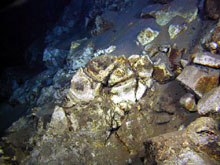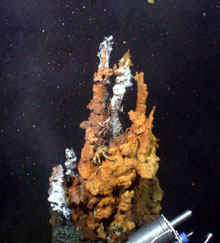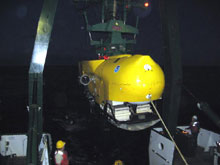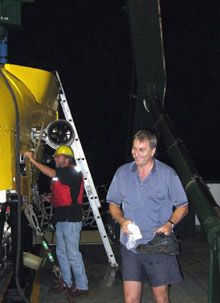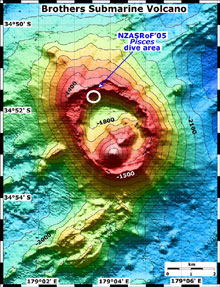
Map view of Brothers submarine volcano. The NZASRoF 2005 Pisces V dives are indicated in the northwest caldera area. The contour interval is 100 meters. The resolution of the bathymetry data is 25 meters. Click image for larger view.
Brothers Volcano
May 9, 2005
Cornel E.J. de Ronde
Geologist
Institute of Geological & Nuclear Sciences (GNS)
Lower Hutt, New Zealand
![]() PiscesV measures
the temperature of the vent fluid coming out of a tall black smoker chimney
at Brothers volcano. (Quicktime, 1.9 Mb.)
PiscesV measures
the temperature of the vent fluid coming out of a tall black smoker chimney
at Brothers volcano. (Quicktime, 1.9 Mb.)
![]() PiscesV explores
a field of large black-smoker chimneys at Brothers volcano. (Quicktime,
1.9 Mb.)
PiscesV explores
a field of large black-smoker chimneys at Brothers volcano. (Quicktime,
1.9 Mb.)
![]() Shrimp, crabs, and scaleworms are found living on the high temperature hydrothermal chimneys at Brothers volcano. (Quicktime, 2.0 Mb.)
Shrimp, crabs, and scaleworms are found living on the high temperature hydrothermal chimneys at Brothers volcano. (Quicktime, 2.0 Mb.)
Brothers volcano is arguably the jewel in the crown of the NZASRoF expedition. It is a caldera volcano, measuring about 8 x 5 kilometers (4.3 x 2.7 nautical miles) on the outside, with the caldera itself 3 - 3.5 kilometers (>1.5 nautical miles) across. The floor of the caldera is 1,850 meters (5900 feet) deep with the surrounding walls about 300 - 450 meters (980 - 1475 feet) high. There is a cone that has formed inside the caldera, and which has joined with the southern caldera walls. All this would make Brothers an impressive view if it were easily visible like the volcanoes of the Taupo Volcanic Zone of New Zealand, now some 400 kilometers (~200 nautical miles) to the southwest of us. But it is the hydrothermal activity at Brothers that makes this volcano exceptional for us.
A few fist-sized pieces of massive sulfides, that is, minerals typically dominated by iron, zinc, lead and copper, had been recovered in a dredge in 1996 from Brothers, by the New Zealand research vessel Tangaroa. Two years later, the German research vessel Sonne towed some cameras and did further dredging, and discovered that there was active hydrothermal venting, in the form of “black smoker” chimneys, along the northwest caldera wall. Less spectacular, but equally important, was evidence for large volumes of “diffuse” venting occurring at the summit of the cone and down its flank, closely associated with a smaller satellite cone.
In 1999, and later again in 2002 and 2004, three separate NZAPLUME cruises mapped the hydrothermal plumes, mainly black smoke, discharging from the various vents over both the northwest caldera and cone sites. It seemed Brothers had many active vents, and that the chemical composition of the cone discharge had changed between 1998/99 and 2002 - possibly due to addition of magmatic material beneath the volcano - after which the composition remained unchanged.
In October of 2004 the Japanese submersible Shinkai 6500 dove four times on Brothers; twice on the northwest caldera site and twice on the cone site. Those dives indeed showed tall (up to 6 meters high) chimneys at the northwest caldera site expelling hot (up to 302° C, 576° F) fluids whereas those at the cone site were much cooler (less than 65° C, 150° F) but very gassy and surrounded by lots of elemental sulfur, with some chimneys up to 8 meters (26 feet) high! But these dives also provided as many questions as they did answers. Why did we not see black smoker chimneys on the cone site when the plume chemistry of 1999 said there should be? And just how big is the northwest caldera site? The field of chimneys seemed endless along the wall of the caldera looking out the portholes of the Shinkai, and they also marched up the slope at least 70 meters! And where was the buried chimney field we thought we saw during the R/V Sonne camera tows?
Now we are back with Pisces V to further explore this exciting volcano. What we need is more information on the size of the northwest caldera site and the location of any 'dead' chimney fields, more insight into the distribution of the vent-related animals, and better understanding of the range of vent fluid chemistry.
So how did we do? First, Bob Embley had a dive that visited the black
smokers previously visited by the Shinkai 7 months earlier, and they
even saw the markers left behind during those dives! They landed in an area
where the rocks were totally altered by the hot (hydrothermal) fluids so
that their original minerals were now completely replaced by other, different
minerals, often much lighter in colour. They also sampled hot fluids (up
to 290° C, 550° F) being expelled by one chimney, sampled a piece
of another dead chimney, then traveled eastwards to try and define the eastern-most
boundary of this very large field (![]() View PiscesV measuring
the temperature of vent fluid). They did find some other active chimneys,
but none related to a large plume anomaly we had detected in this area a
couple of years earlier with the R/V Sonne. Bob and the pilots found
the going tough, as while the bathymetric maps show the sides of the caldera
to be merely 'steep', in actual fact they ranged from very steep, boulder-
and sediment-covered slopes, to vertical walls of massive lava flows, sometimes
many 10's of meters high! This made traversing around the slopes difficult
and sometimes dangerous with overhanging ledges common.
View PiscesV measuring
the temperature of vent fluid). They did find some other active chimneys,
but none related to a large plume anomaly we had detected in this area a
couple of years earlier with the R/V Sonne. Bob and the pilots found
the going tough, as while the bathymetric maps show the sides of the caldera
to be merely 'steep', in actual fact they ranged from very steep, boulder-
and sediment-covered slopes, to vertical walls of massive lava flows, sometimes
many 10's of meters high! This made traversing around the slopes difficult
and sometimes dangerous with overhanging ledges common.
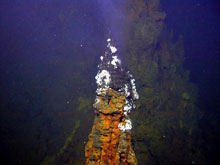
The northwest caldera wall is where we found several tall (up to 4 meters high), active black smoker chimneys. Click image for larger view.
Next, we spent one day recovering some deep (~2 kilometer long) moorings
that had current meters, light scattering and temperature probes attached,
as part of a 6 month experiment to measure the flux of hydrothermal emissions
(plumes) emanating from Brothers volcano (we deployed the moorings during
the Sept/Oct '04 NZAPLUME III cruise). But our biggest challenge now lay
before us…nature. A nasty low on the weather chart meant we were unable
to work for three days which severely cut into the scheduled dives on Brothers.
Our remaining days available to dive on Brothers were cruelly being taken
away from us. So frustrating! And we still had to recover four hydrophones
deployed on the seafloor, also during NZAPLUME III, as part of another experiment
to record acoustic signals the volcano might be generating, for example,
from magma as it moved around several kilometers beneath the seafloor. As
the fourth day dawned since the bad weather began, the seas were fairly
smooth and the sun shining. A good omen. We recovered the hydrophones in
record time which was a relief, as this was our last possible day in which
to do that. By late morning we started to think “maybe we could also
get in a dive today”? We scrambled, the crew aboard the R/V K-o-K and
those with Pisces V double-timed and we were in the water diving
down to 1800 meters (5900 feet) depth by 1:00 PM! Amazing. What a bonus.
It took us almost 1 _ hours to reach the seafloor. We spent less than 2
hours on the bottom but it was well worth it. Soon after we landed, we found
several tall (up to 4 m high) active black smoker chimneys (![]() View PiscesV exploring
black-smoker chimneys at Brothers volcano). We marked their
location, then set off towards the west to try and locate a wall of massive
sulfides the Shinkai had seen right at the end of their last dive, but which
they did not sample. On the way we once again found practically vertical
walls of massive lava flows, sometimes stretching 25 meters up into the
ocean, with very steep slopes in between which appeared as 'shutes' where
rubble would come tumbling down. Time was running out…we found a strange
slope covered in white, sandy material which was covered on its surface
by a shiny metallic mineral called pyrite. We had to press on. Then, as
our time was up (with a timely reminder from the ship that sunset was at
5:30 PM!), we found a field of dead chimneys with two of them 7 meters (23
feet) tall! Incredible. But where was this wall of massive sulfides the
Shinkai had seen? We knew we were close, but not this time. We dropped our
weights and headed up.
View PiscesV exploring
black-smoker chimneys at Brothers volcano). We marked their
location, then set off towards the west to try and locate a wall of massive
sulfides the Shinkai had seen right at the end of their last dive, but which
they did not sample. On the way we once again found practically vertical
walls of massive lava flows, sometimes stretching 25 meters up into the
ocean, with very steep slopes in between which appeared as 'shutes' where
rubble would come tumbling down. Time was running out…we found a strange
slope covered in white, sandy material which was covered on its surface
by a shiny metallic mineral called pyrite. We had to press on. Then, as
our time was up (with a timely reminder from the ship that sunset was at
5:30 PM!), we found a field of dead chimneys with two of them 7 meters (23
feet) tall! Incredible. But where was this wall of massive sulfides the
Shinkai had seen? We knew we were close, but not this time. We dropped our
weights and headed up.
So, did we answer our questions? We never dove on the cone site as those dives were cancelled due to the weather. And we never reached the rim of the caldera where the buried chimneys are thought to be, as we had such limited time on the bottom. But we did add to our knowledge of the extent of the northwest caldera vent field. It is big. Really big. And there are lots of large chimneys. But there is so much more we could do, but such is the lot of trying to study something almost 2 kilometers beneath the waves. Brothers volcano certainly has a lot of treasures, but it is not going to give them up easily! Finally, we surfaced but something seemed odd? Of course, it was dark!
Sign up for the Ocean Explorer E-mail Update List.



























